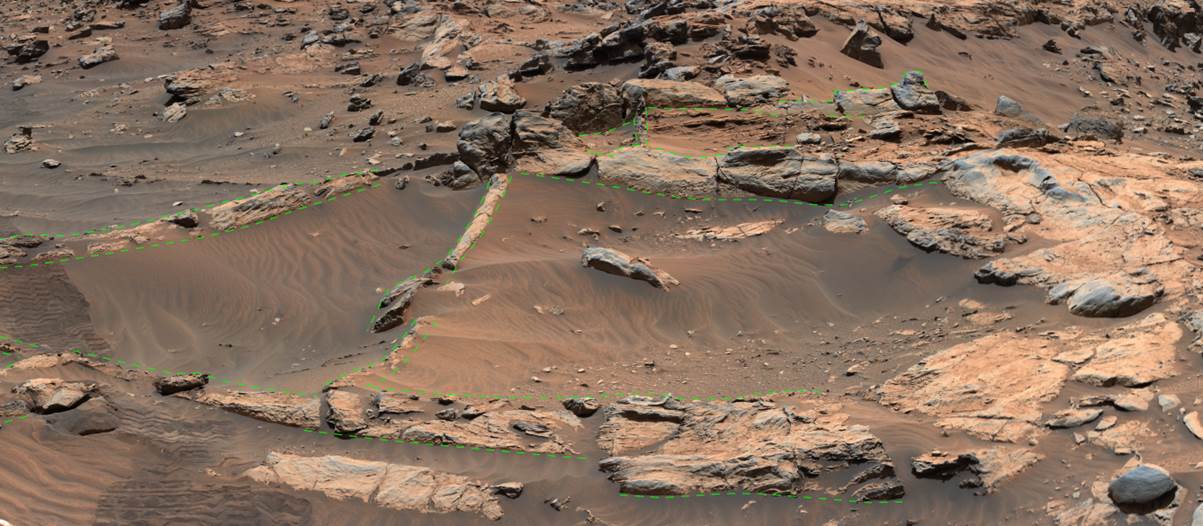Fluidisation of Aeolian Sandstone in Gale crater: evidence for water post-dating exhumation of Mount Sharp
- 1Imperial College London, Earth Science and Engineering, United Kingdom of Great Britain – England, Scotland, Wales (sbanham@imperial.ac.uk)
- 2University of California, Berkeley, CA, USA
- 3University of California, Santa Cruz, CA, USA
- 4Jet Propulsion Laboratory, Pasadena, CA, USA
The overview
Evidence for water and aqueous processes during the initial infilling phase of Gale crater are abundant. Since 2012, the Mars Science Laboratory (MSL) rover Curiosity has investigated a variety of fluviolacustrine environments represented by the Bradbury and Mount Sharp groups. Both units accumulated as a result of sediment transport as bedload by fluvial processes, or by sediment settling from suspension in a lake. What is unclear is the duration that water persisted within Gale crater after the crater infilling was complete. In this contribution, we present evidence of water present within the base of the aeolian Stimson formation, which is recorded in the stratigraphic record by fluidization structures. We will describe the morphology of these structures, the mechanism of emplacement and implications for the history of aqueous processes in Gale crater.
The Background
The Stimson formation is the portion of a broader mound skirting unit which has been directly investigated by the MSL rover. This mound skirting unit unconformably drapes the northern flank of the present-day Mount Sharp. Where encountered on the traverse, the Stimson formation represents the preserved expression of an ancient aeolian dune field. Specifically, the stratigraphic record and the sedimentary architecture indicates that it was a dry dune field: water played no role in the accumulation of this sediment body. This fact is betrayed by the absence of fine-grained interdune deposits, microtopography, or other facies which are characteristic of water at or near the depositional surface. At the time the Stimson formation accumulated, Gale was devoid of surface water.
The Observations
Around Sol 3434, as Curiosity traverse onto the east side of the Greenheugh pediment, it encountered prominent erosion-resistant bedrock ridges which formed a polygonal (boxwork) network. These structures were observed in the basal portion of the Stimson formation, just a few metres above the base Stimson formation unconformity. Internally, these structures consisted of convolute, folded and warped laminations. Laterally, these structures were juxtapose against undeformed Stimson formation: large-scale cross-bedding composed of well-sorted medium-grained sandstones.

Figure1: Polygonal (boxwork) ridges observed at Feòrachas
Closer inspection of these internally-deformed ridge structures yielded evidence of both ductile displacement and destruction of primary stratification in a vertical orientation. The displacement and destruction are localised to the polygonal, linear ridges. Where stratification was displaced, laminations were folded into upright closed antiforms, with a tight bend radi on the hinge. Often, these are adjacent to open-folded synforms. Folding of laminations become tighter and more prominent with increasing vertical distance through the antiforms. Some original cross-laminations exhibited complex, recumbent folding where the underlying bounding surface exhibited open-folded synforms.
In some ridges, such as at the Lamington sandstone target, stratification was destroyed, and was replaced by continuous, vertically-oriented laminations that cross-cut horizontally-orientated laminations adjacent to the ridge (Figure 2). These laminations are oriented parallel to the long axis of the ridges, occasionally displaying vertical fold structures.
In some locations these erosion-resistant ridges contained vertically oriented fractures, with a few subordinate horizontal fractures, which were found to cross-cut some of the ductile deformation.

Figure 2: Close-up view of deformation structures within the Feorachas structure

Figure 3: Lamington Sandstone: example of vertical laminations within a sand dyke
The Interpretation
These structures are interpreted to represent fluidization of sediment caused by water escaping through unconsolidated sediment, under pressure. The linear ridges such as the Lamington structure are interpreted to represent well-cemented sand dykes. The result is the partial or complete destruction of primary sedimentary structures (e.g. cross-bedding) and replacement with secondary sedimentary structures related with fluidization.
The tight antiforms are interpreted to be cusps while the vertical laminations are interpreted as pipes. Synforms, cusps and pipes exhibit pervasive vertical shear. The recumbent folding was also interpreted as evidence of vertical shear due to the displacement of the underlying bounding surfaces into vertical synforms. The vertical shear seen in cusp and synforms, and the vertical laminations observed in the dykes are evidence for the fluidization of sediment caused by upward fluid drag supporting the grain weight as water escapes through an open system under pressure. The source of the fluid may include groundwater upwelling or pore water from liquefaction occurring below the Stimson. As brittle deformation overprinted the soft sediment deformation, the trigger or cause of the fluidization may have been cyclic and caused brittle failure after the sediment regained its strength.
The implications
Regardless of the origin of the water, these fluidization structures provide evidence of persistent water within Gale crater after the exhumation of Mount Sharp, and the accumulation of the Stimson dune field. Presence of this water indicates:
- Water percolated into the base of the Stimson formation, either from fractures within the Mount Sharp group, from strata higher up on Mount Sharp, or from Meteoric sources.
- Water was present at the time which the Stimson formation was unconsolidated: which would be penecontemporaneous with dune field formation.
- This may represent a secondary habitable environment within the lithosphere.
How to cite: Banham, S., Roberts, A., Gupta, S., Dietrich, W., Bryk, A., Rubin, D., and Vasavada, A.: Fluidisation of Aeolian Sandstone in Gale crater: evidence for water post-dating exhumation of Mount Sharp, Europlanet Science Congress 2022, Granada, Spain, 18–23 Sep 2022, EPSC2022-748, https://doi.org/10.5194/epsc2022-748, 2022.

